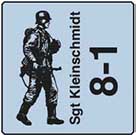D.Ilse
Posts: 330
Joined: 5/2/2009
From: Florahduh, yea that state.
Status: offline

|
I say a small unit on a 60+ map for The American Operation to take Schmidt(Hurtgenwald Camp) Nov.2 to Nov.16, 1944
Areas involved, Towns of Schmidt, Kommerscheidt, Raffelsbrand, Simonskall, Kall Gorge crossing, Hürtgen, Vossenack
Units:
US Army,
28. Infantry Division
> 109.Infantry Regiment
> 110.Infantry Regiment
> 112.Infantry Regiment
146. Engineer Battalion
Elements of US Armour and TD(Towed and SP)
Heer,
116.Panzer Division (Weakened, partial refitting)
>16.Panzer Regiment, I./II. Abteilung, about 30 Pz IV and Pz V
>60.Panzergrenadier Regiment
>156.Panzergrenadier Regiment
>116.Panzer Aufklärungs Abteilung(attacked American supply lines at Kall Gorge)
On Nov.2, An Kampfgruppe of 116.Pz grenadiers were sent to bulk up 74.Korps
74.Korps
89.Infantrie Division(Weakened)
275. Infantrie/Volksgrenadier Division(recently refitted at Aachen before transfer to Hurtgenwald)
>983.Genadier Regiment
>984.Grenadier Regiment
>985.Grenadier Regiment
A little history from Wiki on the 28th's attack and slaughter in the Green Hell.
The 28th Division was reinforced with armor, tracked transport Weasels and air support. Of its three regiments, one was deployed to protect the northern flank, another to attack Germeter, and the third to capture Schmidt, the main objective. The area had terrible terrain with the Kall Trail running along a deep river ravine. This was not tank country, despite the need for armor to support the infantry.
The attack by 28th Division started on November 2; the defenders were expecting it and were ready. The U.S. 109th Infantry Regiment was impeded after 300 yards by an unexpected minefield, pinned down by mortar and artillery fire and harassed by local counterattacks. One mile was gained after two days, after which the 109th dug in and endured casualties. The U.S. 112th Infantry Regiment attacked Vossenack and the neighboring ridge, which were captured on November 2. The 112th was then halted on the Kall by strong defenses and difficult terrain. The U.S. 110th Infantry Regiment had to clear the woods next to the River Kall, capture Simonskall, and maintain a supply route for the advance on Schmidt; again these were very difficult tasks due to weather, prepared defenses, determined defenders, and terrain. The weather prevented tactical air support until November 5.
The 112th captured Schmidt on November 3, cutting the German supply route to Monschau, but no American supply, reinforcement or evacuation was possible, as the Kall Trail was blocked. A strong German counterattack by tanks of 116th Panzer Division and infantry from 89th Division rapidly expelled the Americans from Schmidt, and they were unable to counterattack. For two days, the 112th remained hard pressed to hold its positions outside Schmidt.
On November 6, the U.S. 12th Infantry Regiment was detached from the U.S. 4th Division and sent to reinforce the 28th Division
Across the Kall Bridge the troops of the 28th US Infantry Division pushed forward at the beginning of November 1944 to capture the village of Schmidt. After a few days, the so-called Allerseelenschlacht (All Souls Battle) resulted in a disaster for the Americans. As American troops tried to retreat across this bridge to Vossenack, great parts of the Kall Valley were already cut off by the Germans. A German regimental doctor, Captain Guenther Stuettgen, managed to negotiate an unofficial ceasefire with the Americans at the Kall Bridge from November 7-12, in order to attend to the wounded of both sides. The lives of many American soldiers were saved by German paramedics[10].
At Vossenack, the 2nd battalion of the 112th disintegrated after constant shelling and fled a German attack. Following the providential arrival of two U.S. armored platoons of tanks and M10 Wolverine tank destroyers, supported by those 2nd battalion men who had held tight, and two companies of 146th Engineers operating as infantry, the Americans held on and the fighting for Schmidt continued until November 10.
The battle for Schmidt cost 6,184 U.S. casualties — compared with about 4,000 losses by the two divisions at Omaha Beach. German casualties were fewer than 3,000.[13]
_____________________________
|
 Printable Version
Printable Version























 New Messages
New Messages No New Messages
No New Messages Hot Topic w/ New Messages
Hot Topic w/ New Messages Hot Topic w/o New Messages
Hot Topic w/o New Messages Locked w/ New Messages
Locked w/ New Messages Locked w/o New Messages
Locked w/o New Messages Post New Thread
Post New Thread